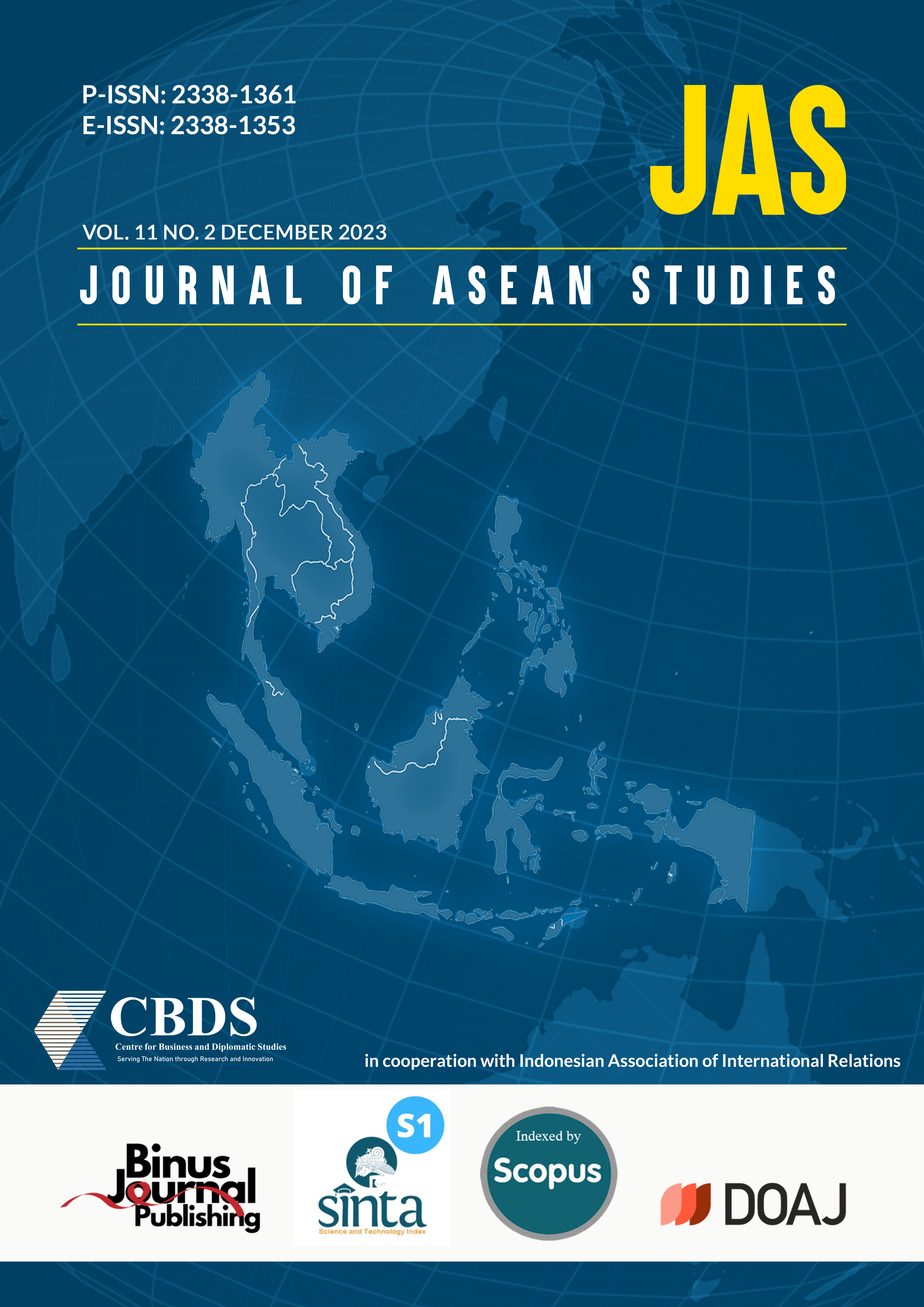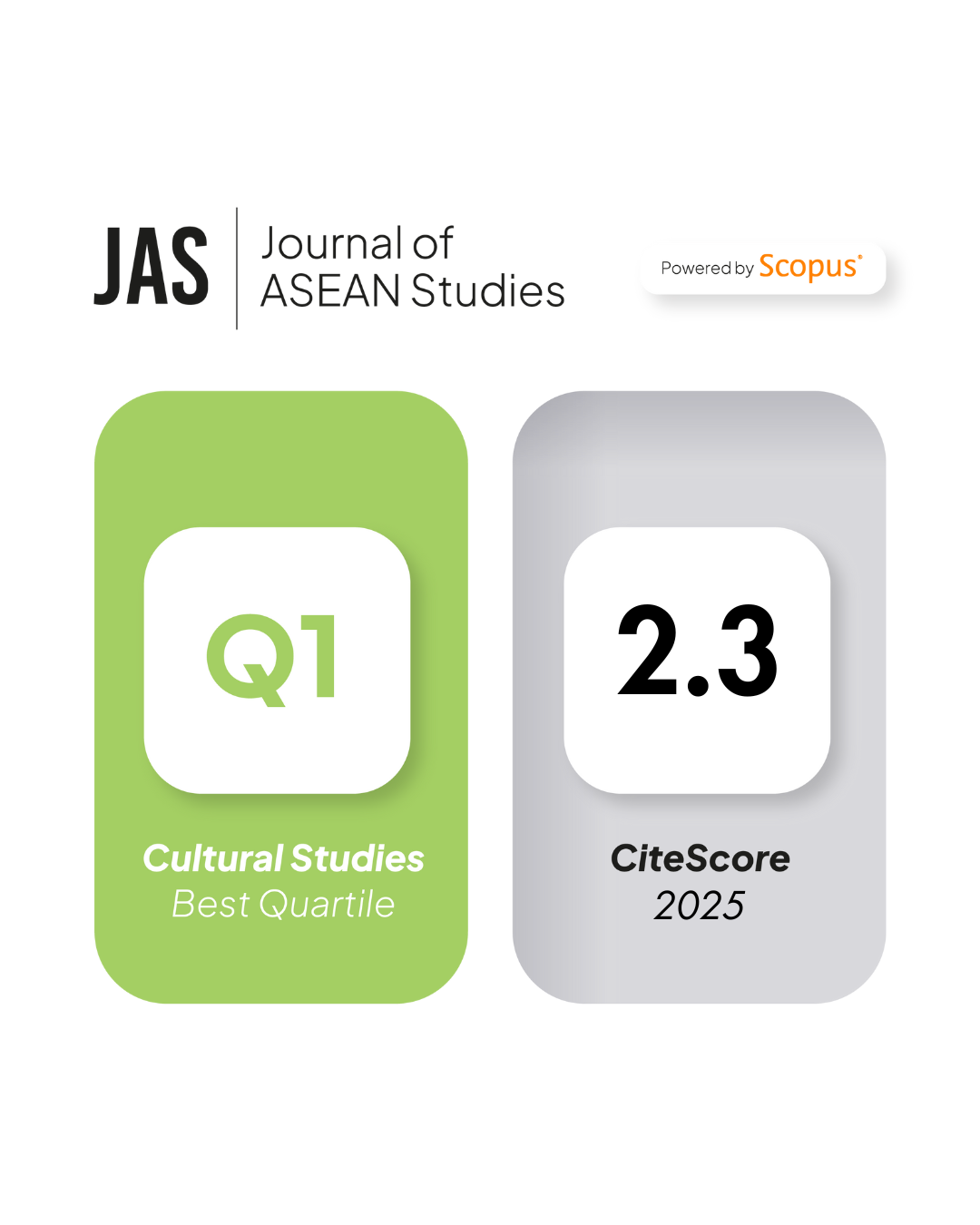China and Regional Security in South and Southeast Asia: A Comparative Analysis of ASEAN and SAARC
DOI:
https://doi.org/10.21512/jas.v11i2.9600Keywords:
regional security, ASEAN, South Asian Association for Regional Cooperation (SAARC), ChinaAbstract
Asian regionalism is largely represented by economic cooperation at sub-regional levels, and the Association of Southeast Asian Nations (ASEAN) is seen as a prominent example of that. In contrast, the South Asian Association for Regional Cooperation (SAARC) has failed to take off as a platform for economic cooperation and has been hostage to the India-Pakistan rivalry. While ASEAN was established as a forum to address members’ security apprehensions concerning China, SAARC was created to focus on regional cooperation in non-controversial matters like trade and human security. Hence, ASEAN has engaged more deeply with China through various mechanisms. Conversely, SAARC-China relations remain limited because India, the most dominant actor in the organization and the region, views China as a threat to its security and hegemony in South Asia. The research, therefore, aims to answer the following question: How does one region successfully manage security challenges/threats while the other remains ensnared by them? Resolving this puzzle necessitates a nuanced understanding of the role of regionalism in Southeast Asia, emphasizing the significance of comprehending the process and evolution of regionalism in this context. To address this inquiry, the research employs a comparative-historical analysis grounded in archival data encompassing both primary and secondary sources. The investigation reveals that SAARC’s limited engagement with China is a consequence of India’s opposition, a dynamic absent in ASEAN, where Indonesia actively supports cooperation with China. The research underscores the critical importance of unraveling the complexities of regionalism in Southeast Asia to grasp the underlying factors contributing to divergent outcomes in these regional organizations.
References
Acharya, A. (2020). Thinking theoretically about Asian IR. In D. Shambaugh & M. Yahuda (Eds.), Internaitonal relations of Asia (pp. 55–86). Rowan & Littlefield Publishers.
Acharya, A. (2017). China and India in the emerging global order: Lessons from ASEAN. In East of India, South of China: Sino-Indian encounters in Southeast Asia (pp. 186–216). Oxford University Press.
Ahmed, Z. S. (2013). Regionalism and regional security in South Asia: The role of SAARC. Routledge.
Ahmed, Z. S. (2020, 11 April). Modi, SAARC and Covid-19. The News. https://www.thenews.com.pk/print/642428-modi-saarc-and-covid-19
Ahmed, Z. S., & Zahoor, M. (2015). Afghanistan in SAARC: A critical assessment of organisational expansion. South Asian Survey, 22(2), 171–188. https://doi.org/10.1177/0971523117748812
Ahmed, Z. S., Bhatnagar, S., & AlQadri, A. (2021) The United Nations Military Observer Group in India and Pakistan: Analysis of perceptions in India and Pakistan. Global Change, Peace & Security, 33(2), 125–141. https://doi.org/10.1080/14781158.2021.1910227
Ali, K. (2020, March 26). China seeks opening of border with Pakistan for medical supplies. Dawn. https://www.dawn.com/news/1543805/china-seeks-opening-of-border-with-pakistan-for-medical-supplies
Ali, S., & Lee, T. F. B. (2022). Deterrence measure: A casue for promoting regional instability in South Asia. Chinese Journal of International Review, 4(2), 1–20. https://doi.org/10.1142/S2630531322500081
Antolik, M. (1987). ASEAN and SAARC revisited: More lessons. Contemporary Southeast Asia, 9(3), 221–228. http://www.jstor.org/stable/25797960
Asfa, R., & Ahmed, M. (2015). Prospects of regionalism: Comparative analysis of SAARC and ASEAN. Asia Pacific, 33, 28–43.
Ashraf, T., Akhir, M. N. M., & Salyana, J. A. (2017). Mapping of track two initiatives: A case of Pakistan-India conflict (1988-2001). Pakistan Journal of Social Sciences, 37(1), 16–29.
Association of Southeast Asian Nations. (n.d.). About us. https://asean.org/about-us/
Attanayake, C., & Haiqi, Z. (2021, June 15). China’s pandemic diplomacy in South Asia. ISAS Insights. https://www.isas.nus.edu.sg/papers/chinas-pandemic-diplomacy-in-south-asia/
Ayoob, M. (1985). The primacy of the political: South Asian Regional Cooperation (SARC) in comparative perspective. Asian Survey, 25(4), 443–457. https://doi.org/10.2307/2644228
Banerji, A. (2021, June 25). India’s flawed vaccine diplomacy. Stimson. https://www.stimson.org/2021/indias-flawed-vaccine-diplomacy/#:~:text=Although%20some%20have%20suggested%20that,Asia%20in%20the%20near%20future
Beeson, M. (2010). Asymmetrical regionalism: China, Southeast Asia and uneven development. East Asia, 27(4), 329–343. https://doi.org/10.1007/s12140-010-9121-0
Beeson, M. (2016). Can ASEAN cope with China? Journal of Current Southeast Asian Affairs, 35(1), 5–28. https://doi.org/10.1177/186810341603500101
Bindra, S. S. (2017). Chinese strategy in South Asia: A critical analysis. World Affairs: The Journal of International Issues, 21(3), 28–49. https://www.jstor.org/stable/48531351
Bose, S. (2021). The dynamics of vaccine diplomacy in India’s neighbourhood. ORF. https://www.orfonline.org/research/the-dynamics-of-vaccine-diplomacy-in-indias-neighbourhood/
Buszynski, L. (2003). ASEAN, the declaration on conduct, and the South China Sea. Contemporary Southeast Asia, 25(3), 343–362. http://www.jstor.org/stable/25798652
Buzan, B. (1991). People, states and fear: An agenda for international security studies in the Post-Cold War era. Harvester Wheatsheaf.
Buzan, B., & Waever, O. (2003). Regions and powers: The structures of international security. Cambridge University Press.
Chandra, A. C., & Lontoh, L. A. (2011). Indonesia – China trade relations: The deepening of economic integration amid uncertainty. International Institute for Sustainable Development. https://www.iisd.org/system/files/publications/indonesia_china_relations.pdf
De Pablos, P. O., & Lytras, M. D. (2010). The China infortmation technology handbook. Springer Science & Business Media.
De Silva, K. M. (1999). The European community and Asean: Lessons for SAARC. South Asian Survey, 6(2), 271–282. https://doi.org/10.1177/097152319900600208
Dutta, T. (2023, March 14). India remains world's top importer of arms supplies. The National. https://www.thenationalnews.com/world/asia/2023/03/14/india-remains-worlds-top-importer-of-arms-supplies/
DW. (2022, 26 July). China, Indonesia agree to boost relations in Beijing meeting. https://www.dw.com/en/china-and-indonesia-agree-to-boost-relations-during-beijing-meeting/a-62605851
English.gov.cn. (2015, March 30). Action plan on the Belt and Road Initiative. State Council of the People’s Republic of China. http://english.www.gov.cn/archive/publications/2015/03/30/content_281475080249035.htm#:~:text=It%20is%20aimed%20at%20promoting,cooperation%20of%20higher%20standards%3B%20and
Embassy of the People's Republic of China in India. (2007, April 3). Remarks by Foreign Minister Li Zhaoxing at the Opening Ceremony of the Fourteenth SAARC Summit. http://in.china-embassy.gov.cn/eng/embassy_news/2007en/200704/t20070403_2375192.htm
Fazal-ur-Rahman. (2011). China and SAARC: Envisaging a partnership for development. Pakistan Horizon, 64(4), 51–65. http://www.jstor.org/stable/24711189
Fazli, Z., Hossain, D., Bhandari, A., Bhattarai, D., Naseem, A., & Attanayake, C. (2022, August 16). India-China competition: Perspectives from the neighbourhood. ORF. http://20.244.136.131/research/india-china-competition
Foot, R. (1998). China in the ASEAN regional forum: Organizational processes and domestic modes of thought. Asian Survey, 38(5), 425–440. https://doi.org/10.2307/2645501
Gerstl, A. (2008). The China factor in regional security cooperation: The ASEAN regional forum and the Shanghai cooperation organization. ASEAS - Austrian Journal of South-East Asian Studies, 1(2), 118–139.
Hao, Y., & Huan, G. (1989). The Chinese view of the world. Pantheon Books.
Ikenberry, G. J. (1999). Institutions, strategic restraint, and the persistence of American postwar order. International Security, 23(3), 43–78. https://doi.org/10.1162/isec.23.3.43
Johnson, D. D. P., & Thayer, B. A. (2016). The evolution of offensive realism: Survival under anarchy from the Pleistocene to the present. Politics and the Life Sciences, 35(1), 1–26. https://www.jstor.org/stable/26372766
Jones, D. M., & Smith, M. L. R. (2007). Making process, not progress: ASEAN and the evolving East Asian regional order. International Security, 32(1), 148–184. http://www.jstor.org/stable/30129804
Karim, M. F., & Chairil, T. (2016). Waiting for hard balancing? Explaining Southeast Asia's balancing behaviour towards China. European Journal of East Asian Studies, 15(1), 34–61. http://www.jstor.org/stable/44162371
Keling, M. F., Som, H. M., Saludin, M. N., Shuib, M. S., & Ajis, M. N. (2011). The development of ASEAN from strategic approache. Asian Social Science, 5(7), 169–189. https://doi.org/10.5539/ass.v7n7p169
Kondapalli, S. (2014). The paradox of China in the Asia-Pacific theatre. Griffith Asia Quarterly, 2(1).
Kumar, S. Y. S. (2015). China’s SAARC membership: The debate. International Journal of China Studies, 6(3), 299–311.
Laksmana, E. A. (2022, August 30). Jakarta gets ‘grey-zoned’ by Beijing. East Asia Forum. https://www.eastasiaforum.org/2022/08/30/jakarta-gets-grey-zoned-by-beijing/
Lee, L., & Lee, J. (2020, February 4). Understanding, analysing and countering Chinese non-military efforts to increase support for, and decrease resistance to, Beijing’s strategic and defence objectives in Southeast Asia. United States Studies Centre. https://www.ussc.edu.au/analysis/understanding-analysing-and-countering-chinese-non-military-efforts-to-increase-support-for-and-decrease-resistance-to-beijings-strategic-and-defence-objectives-in-southeast-asia-indonesia-malaysia-the-philippines-singapore-thailand-vietnam
Liff, A. P., & Ikenberry, G. J. (2014). Racing toward tragedy?: China's rise, military competition in the Asia Pacific, and the security dilemma. International Security, 39(2), 52–91. https://doi.org/10.1162/ISEC_a_00176
Liu, H. (2021). Beyond strategic hedging: Mahathir’s China policy and the changing political economy of Malaysia, 2018–2020. In F. Heiduk (Ed.), Asian geopolitics and the US-China rivalry (pp. 159–176). Routledge.
Madan, T. (2014, November 20). China's Role in SAARC. Brookings. https://www.brookings.edu/articles/chinas-role-in-saarc/
Malone, D. M., & Mukherjee, R. (2010). India and China: Conflict and cooperation. Survival, 52(1), 137–158. https://doi.org/10.1080/00396331003612513
Ministry of Foreign Affairs of the People's Republic of China. (2021, September 16). Overview of China-ASEAN economic and trade relations, opportunities and challenges--Remarks by H.E. Ambassador Huang Xilian, Chinese Ambassador to the Philippines. https://www.fmprc.gov.cn/eng/wjb_663304/zwjg_665342/zwbd_665378/202109/t20210916_9717287.html#:~:text=In%20the%20first%20half%20of,two%2Dway%20investment%20was%20booming
Ministry of External Affairs. (2022). Ministry of External Affairs: Annual Report 2021-2022. Government of India.
Mufti, A., & Ali, I. (2021, February 26). Sino-SAARC trade relations: Commentary and analysis. SSRN. https://papers.ssrn.com/sol3/papers.cfm?abstract_id=3763691
Nabbs-Keller, G. (2011). Growing convergence, greater consequence: The strategic implications of closer Indonesia-China relations. Security Challenges, 7(3), 23–41. http://www.jstor.org/stable/26467106
Napolitano, J. (2013). Development, sustainability and international politics. In L. Meuleman (Ed.), Transgovernance: Advancing sustainability governance (pp. 163–211). Springer. https://doi.org/10.1007/978-3-642-28009-2_4
Narine, S. (2002). Explaining ASEAN: Regionalism in Southeast Asia. Lynne Rienner Publishers.
Noronha, G. (2020, 7 April). SAARC development fund allocates $5 million for Covid-19 projects. The Economic Times. https://economictimes.indiatimes.com/news/economy/finance/saarc-development-fund-allocates-5-million-for-covid-19-projects/articleshow/75026957.cms?utm_source=contentofinterest&utm_medium=text&utm_campaign=cppst
Oba, M. (2019). Further development of Asian regionalism: Institutional hedging in an uncertain era. Journal of Contemporary East Asia Studies, 8(2), 125–140. https://doi.org/10.1080/24761028.2019.1688905
Panda, A. (n.d.). Treaty of amity and cooperation. The Diplomat. https://thediplomat.com/tag/treaty-of-amity-and-cooperation/
Parashar, S. (2021, April 29). India declines China invite to join anti-Covid initiative. The Times of India. https://timesofindia.indiatimes.com/india/india-cold-to-chinas-invite-to-participate-in-joint-fight-against-covid/articleshow/82297253.cms
Pattanaik, S. S. (2022). India’s ‘neighbourhood first’ policy: The primacy of geoeconomics. The Round Table, 111(3), 440–452. https://doi.org/10.1080/00358533.2022.2082774
Pempel, T. J. (2010). Soft balancing, hedging, and institutional Darwinism: The economic-security nexus and East Asian regionalism. Journal of East Asian Studies, 10(2), 209–238. http://www.jstor.org/stable/23418821
Peters, J. E., Dickens, J., Eaton, D., Fair, C. C., Hachigian, N., Karasik, T. W., …, & Wolf, C. (2006). War and escalation in South Asia. Rand Corporation.
Priebe, J., & Rudolf, R. (2015). Does the Chinese diaspora speed up growth in host countries? World Development, 76, 249–262. https://doi.org/10.1016/j.worlddev.2015.07.007
Rasmeefueng, N. (2013). Southeast Asian security complex: The case of the Spratly Islands conflict. Lund University.
Ren, N., & Liu, H. (2022). Southeast Asian Chinese engage a rising China: Business associations, institutionalised transnationalism, and the networked state. Journal of Ethnic and Migration Studies, 48(4), 873–893. https://doi.org/10.1080/1369183X.2021.1983952
Reuters. (2016, August 16). Indonesia actively involved in resolving South China Sea disputes: President. https://www.reuters.com/article/us-southchinasea-indonesia-resolution-idUSKCN10R0BH
SAARC Development Fund (SDF). (2012, November). Chinese ambassador to Nepal visited the SDF secretariat. http://www.sdfsec.org/node/105574
Saez, L. (2011). The South Asian Association for Regional Cooperation (SAARC): An emerging collaboration architecture. Routledge.
Scott, P. D. (1985). The United States and the overthrow of Sukarno, 1965-1967. Pacific Affairs, 58(2), 239–264. https://doi.org/10.2307/2758262
Shekhar, V. (2012). ASEAN’s response to the rise of China: Deploying a Hedging strategy. China Report, 48(3), 253–268. https://doi.org/10.1177/0009445512462314
Singh, B., Singh, S., Singh, B., & Chattu, V. K. (2023). India’s neighbourhood vaccine diplomacy during COVID-19 pandemic: Humanitarian and geopolitical perspectives. Journal of Asian and African Studies, 58(6), 1021–1037. https://doi.org/10.1177/00219096221079310
Stronski, P., & Ng, N. (2018, February 28). Cooperation and competition: Russia and China in Central Asia, the Russian Far East, and the Arctic. Carnegie Endowment for International Peace. https://carnegieendowment.org/2018/02/28/cooperation-and-competition-russia-and-china-in-central-asia-russian-far-east-and-arctic-pub-75673
Sukma, R. (1999). Indonesia and China: The politics of a troubled relationship. Routledge.
Suryadinata, L. (1990). Indonesia-China relations: A recent breakthrough. Asian Survey, 30(7), 682–696. https://doi.org/10.2307/2644558
Taylor, V. (2015). Advancing regionalism and a social policy agenda for positive change: From rhetoric to action. Global Social Policy, 15(3), 329-335. https://doi.org/10.1177/1468018115600123
Thies, C. G. (2002). A pragmatic guide to qualitative historical analysis in the study of international relations. International Studies Perspectives, 3(4), 351–372. http://www.jstor.org/stable/44218229
Wagner, C. (2014). Security cooperation in South Asia: Overview, reasons, prospects. Stiftung Wissenschaft und Politik -SWP- Deutsches Institut für Internationale Politik und Sicherheit.
Wibisono, A. A. (2017). ASEAN-China security relations: Traditional and non-traditional aspects. Global & Strategis, 11(1), 39–54. https://doi.org/10.20473/jgs.11.1.2017.39-54
Widianto, S., & Costa, A. B. D. (2020, January 7). Indonesia deploys fighter jets in stand-off with China. Reuters. https://www.reuters.com/article/us-indonesia-china-idUSKBN1Z61AM
Xinhua. (2021, August 13). Pakistan steers through pandemic scare with help of Chinese vaccines. http://www.xinhuanet.com/english/2021-08/13/c_1310124805.htm
Yee, W. Y. (2021, December 2). Explaining China’s relationship with Indonesia, its gateway to Southeast Asia. The China Project. https://thechinaproject.com/2021/12/02/explaining-chinas-relationship-with-indonesia-its-gateway-to-southeast-asia/
Yeung, J. (2022, December 15). Indian and Chinese troops fight with sticks and bricks in video. CNN. https://edition.cnn.com/2022/12/14/asia/india-china-border-tensions-video-intl-hnk/index.html
Zhang, J., & Sun, Q. (2019). China–India relations: A premature strategic competition between the dragon and the elephant. Issues & Studies, 55(03). https://doi.org/10.1142/s1013251119400046
Zongyi, L. (2014, December 12). China’s economic relations with SAARC: Prospects and hurdles. China Institute of International Studies. https://www.ciis.org.cn/english/COMMENTARIES/202007/t20200715_2766.html
Downloads
Published
How to Cite
Issue
Section
License
Copyright (c) 2023 Salman Ali Bettani, Zahid Shahab Ahmed

This work is licensed under a Creative Commons Attribution-NonCommercial 4.0 International License.






















